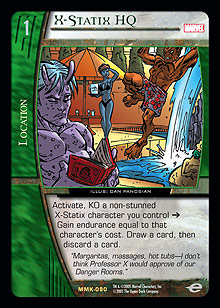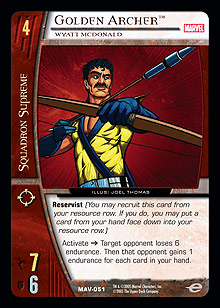
As I mentioned in my last article, the Squadron Supreme’s theme of emptying your own hand was one of the more interesting ideas I’d seen proposed as a direction for a team. There are many facets of game play that you learn as strategies for winning, and at some point, those fundamentals get programmed into a player’s mind so that those decisions can be made on auto-pilot. These decisions include some of the following:
- Each turn you put a plot twist or location face-down into your resource row that you expect to use soon.
- Each turn you play one character with a recruit cost as close to your number of resources as possible.
- Each turn you play a resource.
- Each turn you recover a character you control.
There are also other assumptions that generally hold true. For example, you learn that you generally want to save stat-modifying plot twists for combats later in the game rather than blow them early.
Game Complexity
 There are enough complicated decisions in our game that we don’t want a player to have to spend a lot of time completely reanalyzing too many. On the other hand, we do want decks and teams to feel different in how they play. In an ideal scenario, some of the extra options in a given theme will be compensated for by ease of play in other parts of the game. For example, X-Statix loner changed the importance of playing turns in a manner that minimized how many of your characters got stunned. In fact, in terms of the above examples, it was one of the few decks in which you routinely considered forgoing your free recovery, especially if you hadn’t drawn cards like X-Statix HQ to help you maintain your character count. In the end, many of the play patterns involved in this deck actually simplified game play. There were a number of new decisions to be made, but ultimately, the fact that the deck’s theme involved only one character (or temporarily two characters) simplified combat significantly.
There are enough complicated decisions in our game that we don’t want a player to have to spend a lot of time completely reanalyzing too many. On the other hand, we do want decks and teams to feel different in how they play. In an ideal scenario, some of the extra options in a given theme will be compensated for by ease of play in other parts of the game. For example, X-Statix loner changed the importance of playing turns in a manner that minimized how many of your characters got stunned. In fact, in terms of the above examples, it was one of the few decks in which you routinely considered forgoing your free recovery, especially if you hadn’t drawn cards like X-Statix HQ to help you maintain your character count. In the end, many of the play patterns involved in this deck actually simplified game play. There were a number of new decisions to be made, but ultimately, the fact that the deck’s theme involved only one character (or temporarily two characters) simplified combat significantly.
Squadron Supreme’s empty hand strategy greatly increases the challenge of deciding which resource to play each turn. Once you’ve emptied your hand, you have only the resource row, the top of your deck, and occasionally your KO’d pile to rely on. This is further complicated by the consideration of what you might draw the next turn and how to best manage your resources to keep an empty hand throughout the game. On the flip side, in an attempt to empty you hand, you generally have fewer options at your disposal at later stages of the game. As a result, the overall game complexity balances out.
We have spent a lot of effort encouraging players to play off-curve. One of the limitations of getting players to play off-curve swarm decks comes from this complexity. Players are about to embark on a constructed PCQ season that is largely off-curve. Whether or not you find the format to be diverse enough in terms of deck types, you should let us know how you find the experience of having so many characters in play each turn. And what of the decks with lots of army characters as opposed to lots of unique characters in play? Is having many unique characters too challenging for decision making but having a bunch of similar army characters more reasonable to manage? In this season’s DC Modern Age, complex boards with many characters in play are alleviated by the fact that flight and range are so abundant, thus making formations and attack orders easier. If these characters didn’t have flight and range, do you think things would have been too complicated? Or do you think the boards are already too complicated? The Masters of Evil is one example of a style that under-plays its curve without necessarily putting so many characters into play. Be sure to let us know how well you like the feel of that team, focusing not just in terms of power level, but rather more generally on the use of resource points for non-recruiting effects.
Ease versus Reward
Whenever we work with a new theme, there is a question of how powerful the effects on the cards should be once a player has achieved that theme’s “goal.” In the case of the Squadron, just how powerful should the cards be once a player has an empty hand? The player has paid a cost in deck construction and made sacrifices during game play to reach an empty hand, so what makes for a fair effect?
This question cannot be answered easily without first addressing how challenging it will be to accomplish the goal. When R&D started out designing this theme, I think we expected it to be very hard to empty the hand unless you played a lot of cards with discard costs and effects. As it turns out, just by changing the basics of what players have already learned (specifically switching to playing characters into your resource row and plot twists from the hand), they weren’t too far away from an empty hand in a typical game. To pull this off consistently and as fast as one might desire, at least a few additional ways to help the player out along the way were necessary.
There was some push from design to have cards that would allow you to discard your entire hand for a strong effect. Besides the fact that these might be a little tricky to balance in a sensible way, it seemed like such cards would remove the tension of trying to empty your hand. However, I felt that the tension of emptying your hand was key to the “experience” and strongly rewarded careful deck construction and game play. To put in a card that would allow you to dump your hand trivially seemed like something to be avoided. Sure, the player would suffer from a lack of the options afforded by an empty hand, but other than that, it would diminish the game play aspects I wanted to see rewarded. My personal preference with these things is to make the rewards high and the goal challenging. It is much easier to justify a common 13 ATK/11 DEF 5-cost character when you have to work for it.
As with most new themes, the tricky part is that we hadn’t necessarily envisioned these themes from the outset; there are often pre-existing cards in the Golden Age card pool that do make the goal relatively easy. Thus, we can only get so carried away with the effects. Cards like Break You! come to mind, as well as a number of characters with payment powers requiring discards that are not limited to once per turn. While we can’t do much about past cards, in the Avengers set we avoided making cards that would allow you discard several cards a turn so that we could keep the power of our effects high and interesting. I’m curious to see how cards with additional discard costs will figure into Constructed Squadron decks. While cards like Flame Trap, Break You!, and Weapon of Choice are excellent for getting to an empty hand, they are surprisingly ineffective in the late game once you have accomplished that goal.
 Thus far, I’ve mainly spoken of Constructed. A concern with these types of strategies is how practical it is to reach the goal in Sealed Pack play. The more extreme or novel a strategy is, the more challenging it often is to accomplish. Especially in Sealed Deck, it is often hard to completely empty your hand. As such, we made sure to include some cards that didn’t look just for an empty hand but also looked toward approaching your goal. If you couldn’t get rid of that last card, we didn’t want all of your cards to be dead. Golden Archer and Shape were designed with that consideration in mind for both Sealed and Constructed play.
Thus far, I’ve mainly spoken of Constructed. A concern with these types of strategies is how practical it is to reach the goal in Sealed Pack play. The more extreme or novel a strategy is, the more challenging it often is to accomplish. Especially in Sealed Deck, it is often hard to completely empty your hand. As such, we made sure to include some cards that didn’t look just for an empty hand but also looked toward approaching your goal. If you couldn’t get rid of that last card, we didn’t want all of your cards to be dead. Golden Archer and Shape were designed with that consideration in mind for both Sealed and Constructed play.
The empty hand strategy is fortunately more than reasonable in Draft. I am known to habitually first pick Albert Gaines ◊ Nuke. This past weekend in a Draft game against Brian Kibler, I emptied my hand and attacked on turn 4 with a 16 ATK/9 DEF Blue Eagle, along with the security of a 5-drop reservist in my resource row and a Skymax in my KO’d pile. In Sealed Deck, I’ll admit it isn’t so easy. You’d need to be so focused on the goal that you’d play duplicate characters of the same name for power-ups and many low cost characters to ensure that you always hit your early drops.
Comments welcome at DHumpherys@metagame.com.